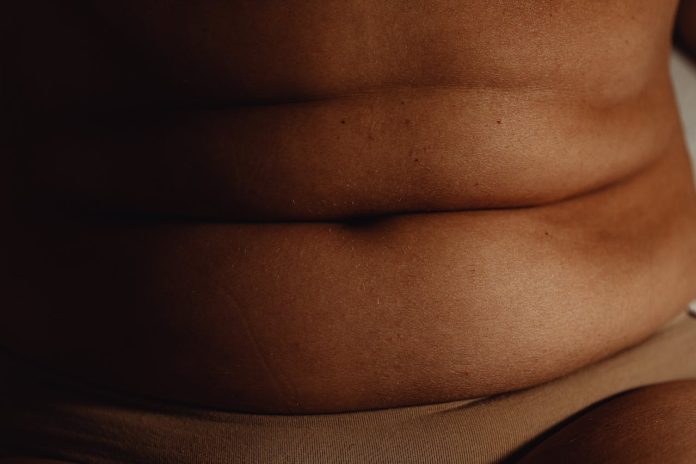She often wraps her little arms around my hips and with wide, bright eyes looks up at me. Her eyebrows are like the antennae of a silk moth — soft, feathery, elongated — and before I can trace my finger across them, she presses her face hard against my belly and blows with all her might. The raspberries she gives me are thunderous and always funny, and this one is no exception. “I love your squishy belly,” my daughter says, letting out a mischievous giggle.
I didn’t always have a squishy belly. In my twenties, long before birthing and breastfeeding two babies, before multiple surgeries, and before the chronic aches of fibromyalgia changed my body, I posed as a pin-up model, often in the nude. In the photographs I now keep as relics, my body looks foreign to me.
As a college student in the U.S., where I was becoming more Americanized after having immigrated a decade before, I approached my own sexuality with a contemporary attitude. Although raised under Catholicism’s strict doctrine of original sin, a belief perhaps more inflexible in Colombia where I was born, I didn’t subscribe to the church’s restraining moral compass. Instead of religious icons, I worshiped the iconic Bettie Page, the 1950s Queen of Pinup who dared to break the established notions of morality of her era. I wanted to imitate her defiant poses, her indomitable stare. She was sex and glam and power condensed into a petite five-foot five frame.
Dressed in waist-cinching leather corsets and tassel pasties, I embodied Bettie; positioning my body for the camera with torso leaning forward, chest and booty curving upwards, giving my back a sultry, concave effect. Like my icon, I was a chameleon passing for a femme fatale. I acted without inhibition, transforming myself into someone who was provocative and sensual, confident and dominant. I made myself the object of desire in front of the lens.
Behind the lens, however, there was a nuanced reality. Paralyzing fear and overwhelming insecurity permeated all aspects of my life. Nightmares were a constant companion, vigilance and panic were my permanent state of mind.
As a young, naïve woman, transforming into the sex symbol that a photo shoot required was a paradoxical task. In the potentially dangerous situation of being alone in a studio with photographers I barely knew, all middle-aged men who required I wear less clothes for shoots, my heart hammered violently against my ribcage, threatening to break through my bones. The torturous thoughts Will I be raped, killed, dismembered, and thrown in a dumpster? inundated my mind. I felt exposed, vulnerable, and yet, the thrill of that very same potential danger kept me hooked. Adrenaline rushed through my veins and had me coming back for more. I loved seeing myself in print. That girl in the photographs was strong, unattainable, and mostly, she was in control. This feeling was my drug.
In my intimate relationships, doubt and shame overshadowed the sexual freedom I presumed I had. I was never genuinely unrestrained, and found that giving myself fully to a romantic partner was impossible. I concealed much about my life, making almost all of these relationships transient by my own design. In my longest relationship, though I had been in love, my partner wasn’t aware of the demons that haunted me, the conceivably risky nude photoshoots, the nightmares in which I’d wake up screaming. In the years we were together, I wove a tapestry of deceit. Each thread, a lie. Each stitch, a more complex story to hide or corroborate previous lies. My brain fought a war between sexual autonomy, morality, and a distorted sense of self-worth in endless loops. Like Bettie, who left the modeling world behind and converted to Christianity because she began to think the Lord disapproved of her nude pictures, I felt extreme guilt. While I had long renounced the notion of religious ethics, it seemed the heavens disapproved of the photos I posed for, of my romances, and mostly of me.
It would be many years before I understood what those feelings of guilt and shame were, or the reasons for needing to have full authority over my own narrative. Having been raised in a country torn apart by drug cartels and civil conflict, I not only witnessed atrocious acts of violence from a very young age, but I also experienced the malevolent touch of various men. These men, young and old, family friends and strangers alike, grabbed at my body parts and took with them my innocence, my confidence, my self-esteem. As the years progressed I became a porcelain doll, chipped and cracked with every wicked hand that violated my body, with every POP POP POP of guns, with the ear splitting BOOM of a car bomb. Having been powerless to my circumstances in childhood, as I entered my twenties in a new and relatively safe country, controlling my life, my body, and the situations around me was a subliminal impulse. The erroneous belief I was in charge, however, only caused more harm.
Recognizing something needed to change, I embarked on a pilgrimage, desperately seeking to break my binding chains, seeking to carve a life free from fear and shame. I stopped engaging in behaviors that caused anxiety and made a conscious decision to not hide who I was, to live as my true self.
In my thirties, I opened up my heart to a man who wanted to know the real me. Unlike the others, he wanted to learn about my past, to understand how my experiences shaped my present, to help me realize the future I sought out. Without judgement, he offered understanding, protection, and boundless love. I was safe in his arms. In our love-making, the universe seemed to look favorably on us too.
With a deep desire to preserve the dream-like life I was building with my husband, I allowed a psychologist to crack my mind open, helping me battle and overcome my torture, my inner demons. In our countless sessions, I learned about “controlled danger,” a nefarious symptom of trauma — a concept I had, all along, understood at a subconscious level. “This is the feeling that by choosing to engage in risk-taking behavior, one is more in control of the situation despite how dangerous that situation may be. In being sexually abused and witnessing first-hand the damages of war, you had not been in control. But, by choosing to be nude for photoshoots with men who were strangers to you, you had the illusion you were in control,” the psychologist explained. Her words were a revelation. Her words released me. Slowly, the nightmares dissipated. Each breath I took came more easily than the last.
Marriage and psychotherapy were not the only factors positively altering my trajectory, however. Motherhood was a catalyst. As my belly grew and expanded exponentially, I never felt more beautiful and whole. The photos I had posed for years before, as alluring and powerful as I felt then, were incomparable to how I radiated in my new rounder shape. Life was suddenly expansive. In birthing two girls, my body transformed from perky and supple to soft and, yes, squishy. My breasts, which my children suckled for close to half a decade, hung low and deflated and the muscles in my abdomen, which had separated to make room for two new lives, weakened and collapsed.
I no longer have the hard, sultry body of fetish fantasies but my new shape has purpose; it is resilient. In my “mom bod” I feel sexy undressing for my husband, and I unabashedly walk around our house naked as an example for my girls to follow because they, too, should feel confident in their skin. And while I do sometimes miss my youthful, thinner frame, the belly I had then would not have been adequate for my girls to blow their most thunderous and humorous raspberries. My now squishy belly has brought me tremendous joy, and in my husband and daughters I’ve found a home and a horizon drenched in light.
Image: KaBoom Pics, Pexels, licensed under CC 2.0.
- Life is Sweet in the Belly of the Beast - February 21, 2025



Absolutely beautiful my friend! Thank you.